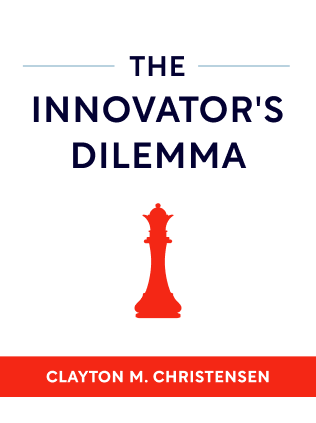

This article is an excerpt from the Shortform summary of "The Innovator's Dilemma" by Clayton M. Christensen. Shortform has the world's best summaries of books you should be reading.
Like this article? Sign up for a free trial here .
What are some disruptive technology examples? How do these case studies show the impact of disruptive innovation?
Disruptive technology examples can be found in a wide variety of industries. It can be a new accounting software, a revolutionary way to bring computers home, or a number of other innovations.
Read on to see four disruptive technology examples and their impacts.
Intuit’s Disruptive Technology
What are some disruptive technology examples? The company Intuit exploited performance oversupply in the financial software market. Intuit disrupted the market with Quicken for personal finances and Quickbooks for small business accounting. Both products were far easier and more convenient to use than competing products.
Existing financial software was robust, capable of producing detailed reports and analyses—but the individuals and small-business owners using the software didn’t need (and often didn’t know how to use) that level of sophistication. The performance oversupply made space for Intuit to take over, and Quickbooks dominated 70 percent of the market within two years of its debut.
Over time, the company maintained its dominance by making the software increasingly simple and convenient—not by adding features. Engineers took their cues from watching how customers used the software, and identifying aspects that might be confusing, instead of acting on the results of market surveys and expert analyses.
Disruptive Technology Examples From the Ink-Jet Printing Industry
When ink-jet printing was introduced, it disrupted the laser-jet printing market. These printers are important disruptive technology examples. Although the new printers had lower resolution and higher cost-per-page, they were also smaller and cheaper per unit than the larger, higher-quality laser-jets.
Hewlett-Packard created a new entity and put it in Washington state to create physical and organizational separation from its main business in Idaho. HP executives even allowed the primary and the disruptive businesses to compete against each other in the market. This benefitted HP in multiple ways:
- It continued to earn laser-jet profits while the technology was dominant in its value market.
- It successfully commercialized the disruptive innovation and brought in profits from its ink-jet organization.
- If laser-jet sales declined with improvements in ink-jet capabilities, HP’s strong presence in the ink-jet market would help the company keep its former laser-jet customers.
Although one of HP’s businesses could end up killing the other, the company positioned itself in the best way to ride the transition from old to new technology.
Disruptive Innovations in the Disk Drive Industry
There are only a handful of disruptive technology examples in the disk drive industry, but they caused established firms to crumble. The most significant of these changes was the shrinking of disk drives.
Two of the most important characteristics of disk drives are physical size and capacity. The industry was in a constant push to fit more data capacity on smaller drives.
In the 1970s, the high-capacity 14-inch drive was standard for mainframe computers, the huge machines used by large businesses for processing data and transactions. Between 1978 and 1980, entrant firms introduced a disruptive technology: a smaller, lower-capacity 8-inch drive.
The 8-inch drive didn’t have enough capacity for mainframes, but it was perfect for the emerging market of minicomputers—mid-sized servers used for business, scientific projects, and databases—which were a step down in size and power from mainframe computers.
At first, the 8-inch drives cost more per megabyte of capacity, even though the drive’s total price was lower than the 14-inch drive. The market tolerated the higher price-per-megabyte because it valued the drive’s smaller size.
Over time, 8-inch drive manufacturers improved capacity and reduced costs so much that the 8-inch drives eventually had a lower cost-per-megabyte than the 14-inch drives. Additionally, the 8-inch drives began invading the 14-inch drives’ market: The 8-inch drives’ capacity had increased enough to suit low-end mainframe computers, eventually pushing 14-inch drives out of the low-end mainframe market.
Personal Computer Industry‘s Disruptive Technology Examples
The evolution of disruptive technologies examples in the computer industry runs parallel to the evolution of disk drive technology, on which computers relied. Established mainframe computer makers were disrupted by the emergence of the minicomputer, which was disrupted by the personal computer, which was disrupted by the laptop.
Two minicomputer makers—Digital Equipment (DEC) and IBM—illustrate two starkly different approaches to confronting the disruptive innovation of personal computers.
DEC marketed personal computer lines four different times between 1983 and 1995, but each time they failed. During each attempt, the company led the personal computer project within its main organization. The problem was that DEC’s established cost structure and value network were incompatible with the value network it needed to enter to be successful in the personal computer market.
By contrast, IBM was successful in its personal computer venture. When IBM launched its personal computer project, it created an independent entity located in Florida, while the company’s main headquarters was in New York. The entity was empowered to take its own approach to creating a cost structure, sourcing component parts, and selling the products, independent of IBM’s main operations.

———End of Preview———
Like what you just read? Read the rest of the world's best summary of Clayton M. Christensen's "The Innovator's Dilemma" at Shortform .
Here's what you'll find in our full The Innovator's Dilemma summary :
- Christensen's famous theory of disruptive innovation
- Why incumbent companies often ignore the disruptive threat, then move too slowly once the threat becomes obvious
- How you can disrupt entire industries yourself






